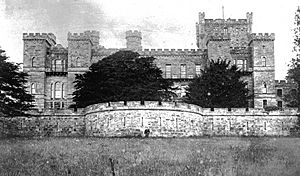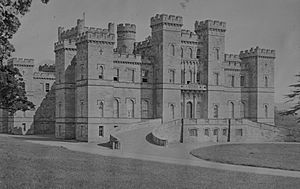Loudoun Castle facts for kids
Loudoun Castle is a grand old house, now in ruins, located near Galston in Ayrshire, Scotland. This amazing 19th-century building is a very important historic site.
Loudoun Castle was once the home of powerful families. It started with the Mure-Campbell family. Later, it became the home of the Rawdon-Hastings family. This happened when Flora Mure-Campbell, who was the Countess of Loudoun, married Francis Rawdon-Hastings in 1804.
The castle we see today was mostly built for Flora. It connected to older parts of the castle from the 15th and 17th centuries. An architect named Archibald Elliot designed the new parts in 1805. People called Loudoun Castle The Windsor of Scotland because it was so big and grand. It had over 90 rooms! The main tower at the back of the building was very impressive. There was also a huge library with more than 11,000 books. It was 100 feet long! Archibald Elliot also planned a large dining hall, but it was never built.
The land around the castle had many different kinds of trees. Many of these trees were brought from America by John Campbell, the fourth Earl of Loudoun. He was a governor in Virginia in 1756. During his travels, he sent home all sorts of valuable trees. He also collected many types of willow trees from England, Ireland, and Holland.
A special stone from Loudoun Castle in Scotland was given to Loudoun County, Virginia, in the United States. This gift was from the Countess of Loudoun. In 2015, the current Earl of Loudoun visited Loudoun County. He even took photos with the local leaders!
Wallace's Famous Sword
Loudoun Castle was once home to a very special item: a sword believed to belong to William Wallace. Wallace was a Scottish hero who fought for Scotland's freedom.
The sword was kept at Loudoun Castle for many years after Wallace's death. It was a treasured family item. The sword was hung in the castle's entrance hall. This hall was very large, about 70 feet long and 30 feet wide. The Wallace Sword was placed in a place of honor on the east wall.
The mother of William Wallace was a daughter of the Loudoun family. This connection meant that the Loudoun family became the guardians of Wallace's sword. It was brought back to the castle in 1868 by the Countess of Loudoun.
Castle Traditions
People say there is a secret tunnel from Loudoun Castle. This tunnel is believed to run under the River Irvine. It supposedly goes all the way to Cessnock Castle, which is more than 2 kilometres (1.2 mi) away!



